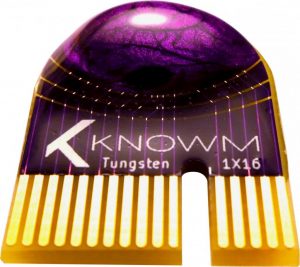Knowm Memristors are impressive, but like all memristors there have remained two issues related to their use in VLSI deep learning accelerators.
The first issue is reliably programming the state of a memristor in a compact and time efficient way. While approaches such as Anti Hebbian and Hebbian (AHaH) Computing embrace online learning over programming, it sure would be nice to accurately program memristor conductances in parallel across a whole array.
The second issue is sneak path currents in large crossbar arrays. Sneak paths have been mitigated by driving all the inputs to the crossbar, but this is a power hungry solution. Transistors have been used as access devices, but this is a space hungry solution. It sure would be nice to have a solution that selectively enabled parts of a crossbar without having to use transistors or electrically drive the whole array.
In our perfect world the solution would be built from the same materials and processes as Knowm memristors. In our really perfect world the solution would provide a photonics interface.
Well, sometimes you just have to pinch yourself. Memristor pioneer and Knowm Memristor inventor Dr Kris Campbell may have just found the solution. Read all about it!

















Leave a Comment